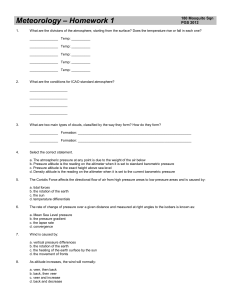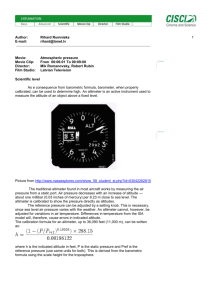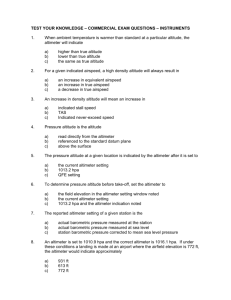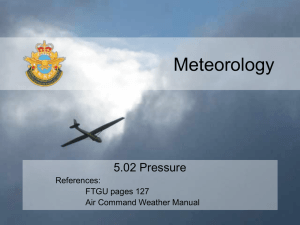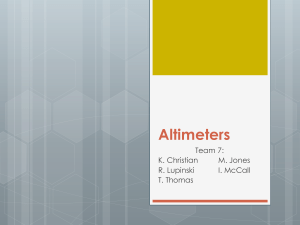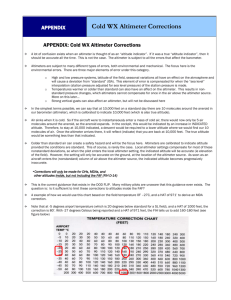Subject - Exp Aircraft Services
advertisement
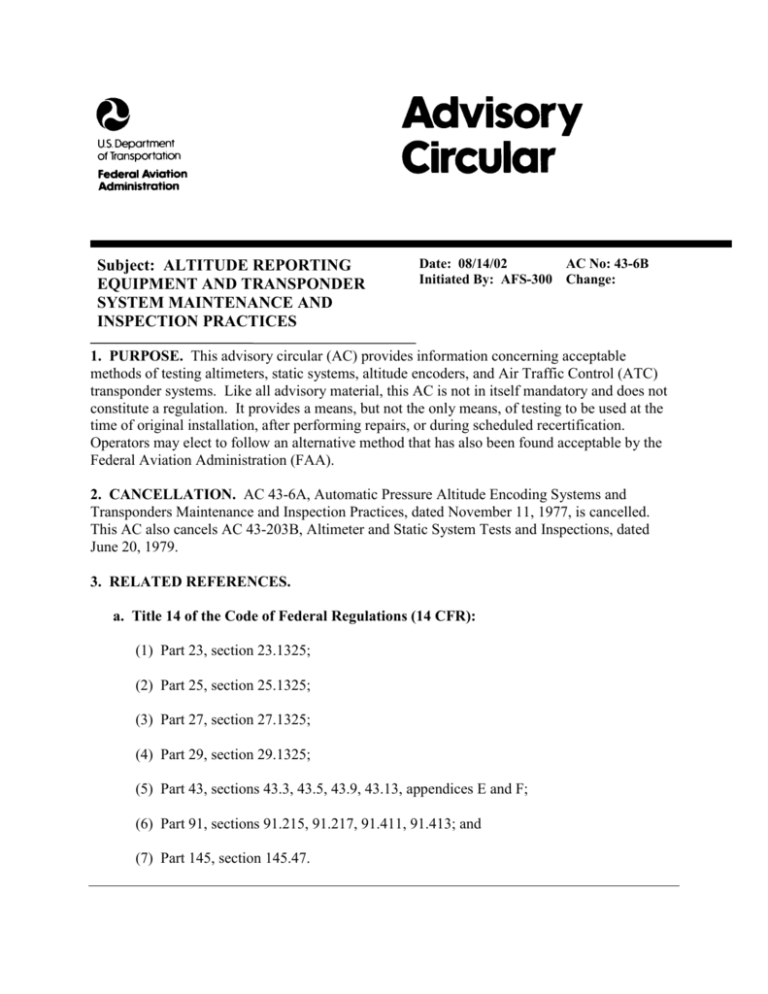
Subject: ALTITUDE REPORTING EQUIPMENT AND TRANSPONDER SYSTEM MAINTENANCE AND INSPECTION PRACTICES Date: 08/14/02 AC No: 43-6B Initiated By: AFS-300 Change: 1. PURPOSE. This advisory circular (AC) provides information concerning acceptable methods of testing altimeters, static systems, altitude encoders, and Air Traffic Control (ATC) transponder systems. Like all advisory material, this AC is not in itself mandatory and does not constitute a regulation. It provides a means, but not the only means, of testing to be used at the time of original installation, after performing repairs, or during scheduled recertification. Operators may elect to follow an alternative method that has also been found acceptable by the Federal Aviation Administration (FAA). 2. CANCELLATION. AC 43-6A, Automatic Pressure Altitude Encoding Systems and Transponders Maintenance and Inspection Practices, dated November 11, 1977, is cancelled. This AC also cancels AC 43-203B, Altimeter and Static System Tests and Inspections, dated June 20, 1979. 3. RELATED REFERENCES. a. Title 14 of the Code of Federal Regulations (14 CFR): (1) Part 23, section 23.1325; (2) Part 25, section 25.1325; (3) Part 27, section 27.1325; (4) Part 29, section 29.1325; (5) Part 43, sections 43.3, 43.5, 43.9, 43.13, appendices E and F; (6) Part 91, sections 91.215, 91.217, 91.411, 91.413; and (7) Part 145, section 145.47. AC 43-6B 08/14/02 b. Advisory Circulars and Technical Standard Orders (TSO). ACs and TSOs may be obtained from the U.S. Department of Transportation, Subsequent Distribution Center, SVC-121.23, Ardmore East Business Center, 3341 Q 75th Avenue, Landover, Maryland, 20785. (1) AC 43-2B, Minimum Barometry for Calibration and Test of Atmospheric Pressure Instruments; (2) TSO-C10, Altimeter, Pressure Actuated, Sensitive Type; (3) TSO-C74c, Airborne ATC Transponder Equipment; (4) TSO-C88a, Automatic Pressure Altitude Reporting Code Generating Equipment; and (5) TSO-C112, Air Traffic Control Radar Beacon System/Mode Select (ATCRBS/Mode S) Airborne Equipment. 4. BACKGROUND. Altitude reporting equipment and transponder systems are significant elements for safe operation of aircraft in the National Airspace System (NAS). ATC monitors aircraft movements and ensures positive separation with identity and 3-D positional information obtained from individual aircraft altitude reporting equipment and transponder systems. Traffic Collision Avoidance Systems (TCAS) installed in nearly all commercial passenger air carrier aircraft and many other aircraft depend on reliable and accurate altitude reporting equipment and transponder systems in surrounding aircraft. Proposals under consideration (such as Automatic Dependent Surveillance Broadcast (ADS-B)) are dependent on other aircraft being equipped with reliable and accurate altitude reporting equipment and transponder systems. 5. INSTALLATION. Any appropriately rated person (as specified in § 43.3) may perform an aircraft alteration that consists of installing or reinstalling equipment (following maintenance). The equipment may consist of an encoding or non-encoding altimeter, air data system components, remote encoding devices (blind encoder), or transponders. The approval of the aircraft for return to service can only be given after a suitable functional check has been performed in order to determine that the altered system will perform its intended function(s) and is approved for return to service per part 43, appendices E and F. NOTE: For those situations where the services of a certificated repair station are used for the installation of an altitude reporting system, or for any component part of such a system, a repair station should posses an Airframe, Radio Class 3, and Instrument Class 1 (all three class ratings are required for the installation of a complete system), or a Limited Class Rating. The repair station ratings may be limited to specific make(s) and model(s) of airframes, transponders, altimeters, or blind encoders. a. Before attempting the installation or reinstallation of an aircraft altitude reporting system, the person installing should ensure the following: Page 2 Par 3 08/14/02 AC 43-6B (1) That required test equipment, technical data, and qualified personnel are available to perform a static system leak check and other testing as required by § 91.411(a)(2), to verify the integrity of the newly installed or altered system. (2) That the capability exists to determine the pressure altitude transmitted by the transponder as referenced against the primary required or pilot’s altimeter (altitude reference § 91.217(b)). (3) That appropriately rated or qualified personnel are available to perform any necessary structural modifications, and appropriate tests and inspections following maintenance or alterations. (4) That an appropriately rated person returns the aircraft to service following alteration or maintenance. (5) That approved data is available to enable return to service of the aircraft following substitution of an encoding altimeter or remote encoding device for the equipment currently listed on the aircraft’s “approved equipment listing.” Equipment that meets the requirements of the appropriate TSO and is certificated to the maximum operating altitude of the intended aircraft may be used to replace equipment listed on the aircraft’s “approved equipment listing” with no further data approval. b. Each installation and inspection should be made in accordance with approved data and the work performed or supervised by appropriately rated persons. Approved data may consist of manufacturer’s drawings, or service bulletins that list replacements or equipment that may be substituted if specifically authorized by the Administrator. c. For Mode S transponder installation, obtain the Aircraft Identification Code from the Aircraft Registry in Oklahoma City at Federal Aviation Administration, Aircraft Registration Branch, Post Office Box 25082, Oklahoma City, OK 73125. Telephone: 405-954-3116. 6. MAINTENANCE. Any appropriately rated person (as specified in § 43.3) may perform maintenance or preventative maintenance on an aircraft altitude reporting and transponder system. This work may include the removal of and/or replacement with an identical component and aircraft altimeter, encoding altimeter, blind encoder, air data system component, or transponder. The approval of the aircraft for return to service can only be given after a suitable functional check of the entire system as installed in the aircraft has been performed in order to determine that the system, as well as the component, will perform its intended function(s). NOTE: In the instance when the services of a certificated repair station are used for the maintenance, preventative maintenance, or replacement of an altitude reporting and transponder system, or for any portion of such a system, the repair station should be appropriately rated as described in the note in paragraph 5. Repair station ratings may be limited to specific make(s) and model(s) of airframes, transponders, or encoding altimeters. Par 5 Page 3 AC 43-6B 08/14/02 7. FUNCTIONAL TESTING. An appropriately rated person, as specified in § 43.3, should make all MAJOR repairs (part 43, appendix A) to component parts of an aircraft altitude reporting and transponder system. Such repairs require testing and inspection before return to service. Following reinstallation into the aircraft, the entire system will be tested for proper function to ensure it performs its intended function(s). The scope of testing required in determining system functionality is dependent on the component parts that were repaired. See Appendix 1, Table 3 to determine the appropriate tests necessary. 8. RECOMMENDED TEST PROCEDURES. The following test procedures provide one way, but not the only way, of demonstrating altitude reporting and transponder system performance and the testing of individual components. In noted instances, these procedures are adequate to demonstrate compliance with the maintenance requirements of §§ 91.411 and 91.413. a. Static Pressure System Test. Performance of this test on all instruments that rely on connected static air will ensure component leak integrity and that no leaks have been introduced while making connections to the encoding altimeter, blind encoder, or other instruments. This procedure is one method of demonstrating compliance with the requirements within § 91.411(a)(2). Persons authorized to perform this test are listed in § 91.411(b). NOTE: Damage may occur to other aircraft instruments, such as the vertical speed indicator, if the altitude rate is changed faster than the limit of the installed instruments. (1) Visually inspect the ports, tubing, accessories, and instruments connected to the static system and repair or replace those parts that are defective (e.g., broken “B” nuts, cracked flare sleeves, deteriorated flexible tubing, bad valves, etc.). Purge the system, if necessary, to remove foreign matter that may have accumulated in the tubing. CAUTION: Be sure to remove all pitot pressure and static air connections to every instrument that is connected before purging the system tubing. (2) Check the static port heater, if so equipped to ensure proper operation by noting either ammeter current or that the pitot tube or static port becomes hot to the touch. (3) When an aircraft has more than one static system, test each system separately to ensure their independence and that the leak rate for each system is within tolerances established in 14 CFR §§ 23.1325, 25.1325, 27.1325 or 29.1325, whichever is applicable. (4) Connect the test equipment directly to the static ports, if practicable. Otherwise, connect to a static system drain or tee connection and seal off the static ports. If the test equipment is connected to the static system at any point other than the static port, it should be made at a point where the connection may be readily inspected for system integrity after the system is returned to its normal configuration. Remove all static port seals after completion of the static system test. Page 4 Par 7 08/14/02 AC 43-6B (5) Test the alternate static system at field elevation to ensure the selection valve functions, if installed. If the reading of the altimeter when on the alternate static pressure system differs from the primary system by more than 50 feet, a correction card should be provided for the alternate static system in accordance with §§ 23.1325, 27.1325, and 29.1325. (6) For unpressurized aircraft, conduct the static pressure system proof test to the standards prescribed in §§ 23.1325(b)(2)(i) or 25.1325(c)(2)(i), as applicable (see paragraph 9). (7) For pressurized aircraft, conduct the static pressure system proof test to the standards prescribed in §§ 23.1325(b)(2)(ii), or 25.1325(c)(2)(ii), as applicable (see paragraph 11 for precautions). (a) An accurate vacuum gauge referenced to atmospheric pressure and connected to the static pressure system may be used to measure the equivalent cabin differential pressure. (b) Either the altimeter in the aircraft under test or that in the test equipment may be used as a vacuum gauge, provided that barometric pressure is converted to pressure in pounds per square inch (PSI). A convenient formula for this conversion is: Inches of mercury PSI = 2.036 (c) The following steps are suggested to use the altimeter as a vacuum gauge: Step 1. Convert the actual local barometric pressure (NOT reduced to sea level) to PSI. Step 2. Subtract the approved maximum cabin differential pressure in PSI from the PSI value obtained in Step 1. Step 3. Convert the PSI value obtained in Step 2 to inches of mercury, using the formula: Inches of mercury = PSI x 2.036. Step 4. The test pressure expressed in inches of mercury can be converted to test altitude using Table IV, Geopotential Altitude, English Units, contained in the document titled “U.S. Standard Atmosphere, 1976 (Stock No. 003-017-00323-0),” which is available from Superintendent of Documents, U.S. Government Printing Office, Washington, D.C. Par 8 Page 5 AC 43-6B 08/14/02 EXAMPLE: Step 1. PSI = 25.39 2.036 = 12.47 PSI Step 2. 12.47 - 5.3 = 7.17 PSI Step 3. Inches Hg = 7.17 x 2.036 = 14.60 inches Hg Step 4. 14.60 inches Hg = 18,600 feet altitude b. Altimeter Certification Test. This test ensures that an altimeter is calibrated and acceptable for use in the NAS. This procedure is adequate to ensure proper operation, but may not fulfill all the requirements of a manufacturer’s minimum performance test required after maintenance of an altimeter. (1) Persons authorized to conduct the altimeter test are listed in § 91.411(b). A certificated mechanic is only authorized to perform static leak testing and is not authorized to perform altimeter testing. (2) Perform the test procedure in part 43, appendix E(b). This procedure demonstrates compliance with the maintenance requirements of § 91.411. Altimeters which are the air data computer type with associated computing systems, or which incorporate air data correction internally, may be tested in a manner and to specifications developed by the manufacturer which are acceptable to the Administrator. (3) The altimeter should be tested on the bench to the maximum altitude of its design specification. The date of the actual altimeter test and maximum in-tolerance altitude should be recorded on the altimeter. An altimeter found to have a lower maximum in-tolerance altitude than its design specification may be put into service provided that the in-tolerance altitude is at least that of the maximum certificated altitude of the aircraft it will be installed in, or if an operational limitation is placed on the aircraft and noted by placard. c. Altimeter Field Elevation Verification. Normal installation of an altimeter or encoding altimeter should not alter its calibration or certification basis. A field elevation verification of performance is adequate after installation to ensure safe operation within the NAS. (1) Persons authorized to conduct the altimeter test are listed in § 91.411(b). A certificated mechanic is only authorized to perform static leak testing and is not authorized to perform altimeter testing. The Altimeter Field Elevation Verification is an observation made at the time of installation and in the context of § 91.411(b), not a test of the altimeter. (2) Compare the altitude displayed on the subject altimeter when referenced to 29.92 inches of mercury (1013.2 millibars) with that of a calibrated reference altimeter (as described in paragraph 9a or b) and ensure agreement within ± 20 feet. Page 6 Par 8 08/14/02 AC 43-6B d. Pressure Altitude Correspondence Test. Ensures that the altitude reporting equipment associated with a radar beacon transponder is calibrated to transmit altitude data corresponding within 125 feet (on a 95 percent probability basis) of the indicated or calibrated datum of the altimeter normally used to maintain flight altitude, as required by § 91.217(b). This procedure is adequate to ensure proper operation of a pressure altitude encoding device installed in a transponder system but may not fulfill all the requirements of a manufacturer’s minimum performance test required after maintenance of an encoder. The following test procedure (in part 43, appendix E(c)) demonstrates compliance with the maintenance requirements of § 91.411. (1) Persons authorized to conduct the altimeter test are listed in § 91.411(b). A certificated mechanic is only authorized to perform static leak testing and is not authorized to perform altimeter or encoder testing. (2) Procedures: (a) Connect the transponder test set so as not to radiate an interfering signal. This may be accomplished by connecting directly to the transponder antenna terminal or to the antenna end of the system transmission line, or by using a test apparatus to shield the antenna. (b) Check to ensure that only the framing pulses (F1 and F2) are transmitted in response to Mode C interrogations when the altitude reporting feature is turned off. (c) Alternately interrogate the transponder on Mode 3/A and Mode C while observing the pulse train output, or the decoded altitude display on those test sets capable of decoding the pulse train. (d) Set the altimeter normally used to maintain flight altitude to 29.92 inches of mercury (1013.2 millibars). (e) Apply suction to the static system, or directly to altimeter, and compare transponder altitude output with altimeter-displayed altitude at the test points in Appendix 1, Table 1 (Abbreviated Correspondence Test) or Table 2 (Correspondence Test). Test each point while increasing altitude and while decreasing altitude. If separate static systems serve altimeters and digitizers, simultaneously apply identical pressures to each. Approach each test point slowly, decreasing pressure for increasing altitude and vice versa, until a transition to the test point value occurs in the digital output. Apply vibration to a pneumatically driven altimeter when taking readings to reduce any error due to friction. Record the altimeter reading at the instant of digital code transition. A test association matrix (Appendix 1, Table 3) is provided to assist in the determination of the appropriate test to perform. (3) Encoding digitizers, which are separate units (blind encoders) having their own individual pressure sensor, should be checked against the pilot’s altimeter upon installation to ensure that the overall system accuracy is met. In addition, where an installation allows for the blind encoder to be connected to a static source other than the static source connected to the altimeter normally used to maintain flight altitude, the following corrections should be applied during certification of compliance to § 91.411(a): Par 8 Page 7 AC 43-6B 08/14/02 (a) The difference between both static sources should be determined and recorded. (This information may be available from the original aircraft certification data.) (b) The differences determined in (3)(a) above (static source errors) should be used as a correction factor when checking for compliance with § 91.217(b). (4) Altitude encoding devices not connected to a transponder but interfaced with other equipment should be tested according to steps (2)(d) and (e), using Appendix 1, Table 1. Units not equipped with a display or means of monitoring altitude input should be tested as possible to ensure data integrity. e. Transponder Test and Inspection. This test ensures the proper operation of a transponder in the NAS. This procedure is adequate to ensure proper operation of a transponder system but may not fulfill all the requirements of a manufacturer’s minimum performance test required after maintenance of a transponder. This procedure demonstrates compliance with the maintenance requirements of § 91.413. (1) Persons authorized to conduct transponder tests and inspection are listed in § 91.413(c). (2) Perform the test procedure in part 43, appendix F. (3) Perform an ATCRBS-Only All-Call test. Interrogate the transponder with an ATCRBS/Mode S All-Call interrogation signal at a nominal repetition rate of 235 interrogations per second and at a signal level 3 dbm above receiver minimum trigger level. Adjust P4 pulse equal in amplitude to P3 pulse and verify that the reply rate is equal to or greater than 223 replies per second. (4) Bench Tests. Transponders may be bench-tested to manufacturer’s specifications for compliance with § 91.413 and functionally checked after installation in the aircraft, provided that during the bench check the transponder operates into an antenna system presenting the same Voltage-Standing Wave Ratio (VSWR) characteristics and cable attenuation as that in the airplane. (5) Removal and Replacement. Removal and replacement of transponder units, subsequent to testing a system in accordance with § 91.413, will not invalidate the test results. A repaired or replacement transponder may be installed without repeating § 91.413 testing; however, a manufacturer’s minimum performance test will be performed before return to service. Any time the aircraft connections to a transponder have been removed and reconnected, each altitude reporting code line (in the case of the newer aircraft, the digital data bus) must be tested for integrity of connection. Integrity of connection for systems using a digital data bus to convey altitude information to a transponder may be verified by successful reporting of a single altitude. Integrity of connection for systems using Gillham code connections may be verified by performing an abbreviated correspondence test at the test points of Appendix 1, Table 1 using the installed automatic pressure altitude encoding device or through the use of an encoder substation test unit capable of simulation of the Appendix 1, Table 1 altitudes. Page 8 Par 8 08/14/02 AC 43-6B 9. ALTIMETER TEST EQUIPMENT. The following test equipment is acceptable for testing altimeters: a. Mercurial, aneroid, or digital barometers with accuracy specified in and in accordance with AC 43-2B, Minimum Barometry for Calibration and Test of Atmospheric Pressure Instruments, and newer equipment with accuracies that meet Reduced Vertical Separation Minimums (RVSM) tolerances. b. High accuracy portable test equipment (with correction card, if appropriate) maintained in accordance with § 145.47(b). Calibration checks of the test equipment in accordance with the following schedule provide a satisfactory level of performance: (1) Each 30 days, after initial calibration, the equipment should be checked for accuracy against: (a) A barometer described in paragraph 9a; or, (b) An altimeter (with appropriate correction card) which has been calibrated, within the past 30 days, against a barometer described in paragraph 9a. (2) Before use, the equipment should be checked for proper operations within calibration limits at station pressure using a digital, aneroid, or mercurial barometer, or in accordance with paragraph 9a. (3) The 30-day calibration period in paragraph 9b(1) may be extended, provided the calibration records of the individual test equipment reflect continued accuracy as specified by technical information or recommendations of the equipment manufacturer. 10. MAINTENANCE RECORD ENTRY. The following example of a permanent maintenance record entry will be satisfactory for compliance with § 43.9: EXAMPLE: I certify that the altimeter and static system tests required by 14 CFR § 91.411 and transponder tests, including data correspondence, required by § 91.413, have been performed and found to comply with 14 CFR part 43, appendix E and F. Altimeter Model _________________ Transponder Model ______________ Encoder Model __________________ Serial No. ____________________ Serial No. ____________________ Serial No. ____________________ The altimeter was tested to______ feet on (date of altimeter test) The transponder was tested on (date of transponder test) Encoder data correspondence was tested to _______ feet on (date of correspondence test) Static system leak tested on (date of static test) Signature___________________________________ Certificate Number___________________________ Par 9 Page 9 AC 43-6B 08/14/02 11. TESTING PRECAUTIONS. This section contains precautions that should be taken during tests to avoid damage to the sensitive instruments connected to static systems. a. Before testing any static system, determine that the design limits of instruments attached to it will not be exceeded during the test. To determine this, locate and identify all instruments attached to the system. In addition to the altimeter, airspeed, and rate of climb, many airplanes use static pressure for the operation of autopilots, flight recorders, air data computers, altitude reporting digitizers, etc. The use of a static system diagram of the airplane involved may be helpful in locating all of the instruments. If a diagram is not available, locate the instruments by tracing the physical installation. b. Damage can occur to instruments that are connected to both the static system and pitot system when only the static system is evacuated. The maximum design differential pressure of these instruments may be exceeded. One method to prevent this type of damage is to tie both the pitot and static systems together when conducting static system checks. This should result in zero differential pressure regardless of the degree of static system evacuation. Note that a leak in either system will affect the test process. c. Safeguards should be taken to prevent accidental disconnection of the test equipment plumbing from the aircraft or the test equipment while the static system is evacuated. The resultant sudden pressure change may damage both the test instruments and the aircraft instruments. The aircraft static system should be returned to ambient pressures before disconnecting static test equipment from the system. d. If static ports are blocked for the purpose of testing, it is recommended that a bright colored tape (red or orange) or similar method of warning be attached with the blockage device. e. The barometric correlation adjustment of an altimeter should not be adjusted in the field; changing this adjustment will nullify the correspondence between altimeter and its encoding digitizer or the associated blind encoder. Barometric correlation adjustment of an altimeter is considered a repair action and should not be performed without an appropriate instrument or repair station limited rating. f. Some altimeters may exhibit a tendency toward jerkiness (when not under vibration). If the jerkiness appears excessive, then the friction test should be conducted as described in part 43, appendix E. g. Some encoders may exhibit errors and excessive drift during initial warm-up. Lack of correspondence within 125 feet between altimeter and encoder, if observed five minutes after initial power turn-on or later, should be considered failure to meet the standards of § 91.411(a). Subsequent retesting should only be performed after repair of the encoder. h. Adjustment of encoder calibration, including high or low reference settings, is considered a repair action not part of certification and requires an appropriate instrument or limited rating. Limited ratings authorizing the test of encoders only do not include authorization for this adjustment. Page 10 Par 11 08/14/02 AC 43-6B NOTE: No field adjustments are allowed unless the repair station is rated for this adjustment. 12. INSTALLATION AND TESTING CONCERNS. a. The blind encoder, altimeter, air data system components, and encoding altimeter should have an altitude encoding capability of at least the service ceiling or maximum certificated altitude of the aircraft in which it is installed. If the altitude reporting system will not function throughout the aircraft operational envelope (up to the aircraft maximum operating altitude), install a placard stating the aircraft altitude limitation. b. Install the altimeter and encoder in the same environmental location unless specific FAA Engineering approval is obtained. c. Altitude reporting system installations (either blind encoder or encoding altimeter types) may be shop-tested for correspondence (using the transponder decoded output) and then functionally checked after installation in the aircraft, provided the transponder encoding digitizer, altimeter, wiring harness, and coaxial cable are either installed in the aircraft or accurately compensated for. d. Transponder antenna systems may deteriorate to the point that they pull transponder frequency out of tolerance. If this is observed, the antenna system should be repaired. The practice of offsetting transponder output frequency to compensate for antenna system pull is not acceptable. e. Whenever blockage of the static lines is suspected, they should be purged before performing the static pressure system test. Besides the obvious benefits of removing foreign objects from the lines, purging may keep such objects from entering the test equipment. Since purging applies positive pressure to lines, the following precautions should be taken: (1) Disconnect all instruments and air data sensors; (2) Cap off those lines not being purged; (3) Restrain hoses that can whip due to purge pressure; (4) Ensure that lines are clear by feeling discharge pressure at ports; and (5) Clean system drains and traps after purging since they can act as a sump for foreign material. /s/ Lou Cusimano for James J. Ballough Director, Flight Standards Service Par 11 Page 11 (and 12) 08/14/02 AC 43-6B Appendix 1 APPENDIX 1. TABLES TABLE 1. ABBREVIATED CORRESPONDENCE TEST ALTITUDE INFORMATION PULSE POSITIONS RANGE PULSE POSITION (0 or 1 in a pulse position indicates absence or presence of a pulse, respectively) INCREMENTS (FEET) -1000 -900 -700 -400 -200 800 2800 6800 14800 30800 D4 A1 A2 A4 B1 B2 B4 C1 C2 C4 0 0 0 0 0 0 0 0 0 1 0 0 0 0 0 0 0 0 1 1 0 0 0 0 0 0 0 1 1 0 0 0 0 0 0 0 1 1 0 0 0 0 0 0 0 1 1 0 0 0 0 0 0 0 1 1 0 0 0 0 0 0 1 1 1 0 0 0 0 0 0 1 1 0 0 0 0 0 0 0 1 1 0 1 0 0 0 0 0 0 0 0 0 1 1 1 1 1 1 1 Integrity of code lines is ensured through testing at these increments. Page 1 AC 43-6B Appendix 1 08/14/02 APPENDIX 1. TABLES (cont’d) TABLE 2. CORRESPONDENCE TEST ALTITUDE INFORMATION PULSE POSITION RANGE PULSE POSITION (0 or 1 in a pulse position indicates absence or presence of a pulse respectively) INCREMENTS (FEET) D4 A1 A2 A4 B1 B2 B4 C1 C2 - 1050 to - 950 - 50 to + 50 450 to 550 950 to 1050 1050 to 1150 1250 to 1350 1450 to 1550 1750 to 1850 1950 to 2050 2550 to 2650 2650 to 2750 2950 to 3050 3950 to 4050 5950 to 6050 6750 to 6850 7950 to 8050 9950 to 10050 11950 to 12050 13950 to 14050 14750 to 14850 15950 to 16050 17950 to 18050 19950 to 20050 21950 to 22050 24950 to 25050 29950 to 30050 30750 to 30850 34950 to 35050 39950 to 40050 44950 to 45050 49950 to 50050 Page 2 0 0 0 0 0 0 0 0 0 0 0 0 0 0 0 0 0 0 0 0 0 0 0 0 0 0 1 1 1 1 1 0 0 0 0 0 0 0 0 0 0 0 0 0 0 0 0 0 0 0 1 1 1 1 1 1 1 1 1 1 1 0 0 0 0 0 0 0 0 0 0 0 0 0 0 0 1 1 1 1 1 1 1 1 1 1 0 0 0 0 1 1 1 0 0 0 0 0 0 0 0 0 0 0 1 1 1 1 1 1 0 0 0 0 0 1 1 1 0 0 1 1 0 0 0 0 0 1 1 1 1 1 1 1 1 1 1 0 0 0 1 1 0 0 0 1 1 0 1 0 0 1 0 0 1 0 1 1 1 1 1 1 0 0 0 0 0 1 0 0 1 0 1 0 0 1 0 1 0 1 0 0 0 1 1 0 0 1 0 0 0 1 1 1 1 0 0 0 1 1 0 1 1 1 1 0 1 1 1 1 0 1 0 0 1 0 1 0 0 0 0 1 1 0 0 0 0 0 0 0 0 0 0 0 0 0 0 0 0 0 0 0 0 0 0 0 0 0 1 1 1 1 1 0 1 0 1 1 0 1 1 1 0 1 1 1 1 0 1 1 1 1 1 1 0 1 1 1 1 C4 0 0 0 0 0 0 0 1 0 1 1 0 0 0 1 0 0 0 0 1 0 0 0 0 0 0 1 0 0 0 0 08/14/02 AC 43-6B Appendix 1 APPENDIX 1. TABLES (cont’d) TABLE 3. TEST ASSOCIATION MATRIX The following table lists appropriate tests to assure system functionality after removal, replacement, or installation of altitude reporting equipment and transponder system components. COMPONENT DESCRIPTOR TEST(S) Altimeter Pilot reference 1. Field elevation verification 2. Correspondence test 3. Static leak test Altimeter Pilot reference 1. Field elevation verification Matched to encoder prior to 2. Abbreviated correspondence installation test 3. Static leak test Altimeter Other than pilot reference 1. Field elevation verification 2. Static leak test Encoding altimeter Pilot reference 1. Field elevation verification 2. Abbreviated correspondence test 3. Static leak test Encoding altimeter Other than pilot reference 1. Field elevation verification 2. Correspondence test 3. Static leak test Encoding altimeter Other than pilot reference 1. Field elevation verification Matched to pilot reference 2. Abbreviated correspondence altimeter prior to installation test 3. Static leak test Blind altitude encoder Connected to transponder 1. Correspondence test 2. Static leak test Blind altitude encoder Connected to transponder 1. Abbreviated correspondence Matched to pilot reference test altimeter prior to installation 2. Static leak test Blind altitude encoder Not connected to transponder 1. Abbreviated correspondence test (modified) 2. Static leak test High Reliability Style Connectors designed to or Connectors meeting Military or similar Industry standards Pilot Reference The altimeter normally used to Altimeter maintain flight altitude. Transponder High reliability style connector 1. Transponder test and inspection system Transponder Non-high reliability style 1. Transponder test and inspection connector system 2. Abbreviated correspondence test Page 3 (and 4) 08/14/02 AC 43-6B Appendix 2 APPENDIX 2. GLOSSARY OF TERMS. 1. Approved: Unless used with reference to another person, means approved by the Administrator. 2. Blind Encoder (Digitizer): An altitude reporting encoder that is pressure operated, having no altitude display; is not part of a pressure/altitude indicating device or system; does not contain an external means for barometric setting and may supply altitude reporting information to the A.T.C. transponder, GPS, or other onboard system. 3. Calibrated Datum of the Altimeter: The correction applied via a specific calibration card applicable to a specific altimeter to correct for instrument error (scale error) only. 4. Correspondence: The maximum absolute difference between altimeter display and encoder output for a constant encoder output. The altimeter's displayed pressure/altitude (referenced to 29.92) compared to encoded altitude output from the blind encoder or encoding altimeter; for the entire period (from the moment that the code output changes to a value to the moment the code output changes to the next value while the pressure/altitude is changing). 5. Data: Drawings, sketches, stress analysis, reports, operating limitations, or photographs that support or describe an alteration. 6. Encoding Altimeter (Pressure Altitude): An altitude indicator that displays to the pilot the pressure/altitude sensed by the device and produces an altitude reporting output. 7. Indicated Datum of the Altimeter: The altitude displayed by the altimeter when an ideal absolute pressure is applied to the sensing member of the altimeter, and not corrected for instrument error (scale error), nor corrected for static source error. 8. Matched Components: An altimeter and a blind encoder, which have been tested and calibrated together and, as a combination, meet the requirements of § 91.411(a). Page 1 (and 2)
